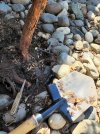I just took apart an alox MiniChamp with a cheap dollar store screwdriver. I used a 1/4" hex drill bit, size 5/64" inserted into the screwdriver, and I used that screwdriver to drill the rivets out by hand. A 1/16" drill bit probably would've worked fine too. They're very close in size.
The alox scale appears to have zero damage. Unsurprisingly, it turns out that you are easily able to avoid mistakes when you are going super slow. It took me over an hour to get through all 4 rivets. I think I could do it a lot faster, but I was being overly cautious since this was my fist time.
The drill bit was old, used, and corroded. I guess none of that matters when you're only using it to go through soft brass at a snail's pace. This is yet another example showing that you don't need much skill or any special tools to start modding.
...except for a tiny ball peen hammer. You do need one of those. So far, that's the only "special" tool I've needed, and I only consider it special because most people don't own one. The rest of the stuff I've needed were basic affordable common everyday tools that almost everyone already has. I have also used a small bench vise, and that is less common, but I'm pretty sure I could've gotten away with using a small table vise or a clamp.
edit: What should I do now?
I currently have this thing reassembled as a knifeless Rambler (scissors, SD ruler, phillips, nail cleaner file).
I could peen it like that, or I could strip it down further and make an alox Jetsetter (scissors, phillips). That would make it the same thickness as an alox Classic SD.
I could also add another layer instead. Maybe the package opener and the cuticle pusher...
Or I could take apart a Classic SD and use the SD nail file to make an actual alox Rambler.
Or I could do some other configuration.
What should I do?
The alox scale appears to have zero damage. Unsurprisingly, it turns out that you are easily able to avoid mistakes when you are going super slow. It took me over an hour to get through all 4 rivets. I think I could do it a lot faster, but I was being overly cautious since this was my fist time.
The drill bit was old, used, and corroded. I guess none of that matters when you're only using it to go through soft brass at a snail's pace. This is yet another example showing that you don't need much skill or any special tools to start modding.
...except for a tiny ball peen hammer. You do need one of those. So far, that's the only "special" tool I've needed, and I only consider it special because most people don't own one. The rest of the stuff I've needed were basic affordable common everyday tools that almost everyone already has. I have also used a small bench vise, and that is less common, but I'm pretty sure I could've gotten away with using a small table vise or a clamp.
edit: What should I do now?
I currently have this thing reassembled as a knifeless Rambler (scissors, SD ruler, phillips, nail cleaner file).
I could peen it like that, or I could strip it down further and make an alox Jetsetter (scissors, phillips). That would make it the same thickness as an alox Classic SD.
I could also add another layer instead. Maybe the package opener and the cuticle pusher...
Or I could take apart a Classic SD and use the SD nail file to make an actual alox Rambler.
Or I could do some other configuration.
What should I do?
Last edited:





